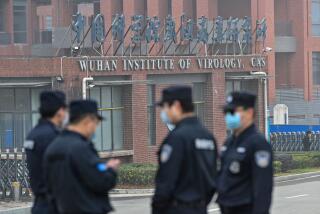Altering AIDS Virus May Lead to Vaccine
- Share via
WASHINGTON — Scientists at the National Cancer Institute have reported new understanding of the working of the AIDS virus that they said possibly could result in a vaccine to prevent the deadly disease and produce a potential life-saving therapy for already infected persons.
Researchers at the institute said that they have found a way to alter the AIDS virus so that it no longer destroys its primary target in the body’s immune system.
By removing a piece of a key gene in laboratory experiments, the researchers said, the resulting virus continues to replicate and be infectious but does not kill so-called T-4 “helper” cells, a critical part of an individual’s immune system defenses against invading organisms.
Research Called Preliminary
But the scientists cautioned that they still are in the preliminary stages of research and much work remains to be done on possible vaccines and therapies. Furthermore, some other AIDS researchers dispute the new finding reported by the NCI specialists.
Robert C. Gallo, head of NCI’s laboratory of tumor cell biology and the American credited with discovering the virus that causes AIDS, described the altered virus at a meeting earlier this week convened by the National Institute of Allergy and Infectious Diseases to discuss the progress of AIDS vaccine research.
The “mutant,” as NCI scientists have dubbed it, has major implications as a possible “starter” material for a vaccine to prevent the deadly disease or as a treatment to halt further crippling of the immune system in an already infected person, said Flossie Wong-Staal, a member of the institute research team.
AIDS, or acquired immune deficiency syndrome, destroys the body’s immune system by selectively killing the T-4 cells, leaving the individual powerless against certain cancers, neurological disorders and otherwise rare infections.
Wong-Staal said that a vaccine developed from such an altered virus would offer “an added layer of safety” from infection over vaccines derived from the “wild,” or natural, virus.
However, she said, “I think a more exciting aspect of it is to really think of it as a potential therapy.” She added: “If you give it (the altered virus) to people already infected, and if it goes into the uninfected cells of an infected person, these cells will be protected from future infection from the wild virus.”
The effect would be to preserve a population of T-cells, she said, thus preventing further deterioration of the immune system.
Although the wild virus may still prevail in the human body, “it will be competing (with the altered virus) for target cells,” she said.
“Hopefully, you will always preserve a population of target cells,” Wong-Staal added. “The ones infected by the wild virus will die, but the others will be protected--so you won’t completely deplete the pool.”
She emphasized, however, that because the AIDS virus is known to infect other cells in the body, including those in the brain, “a lot more preliminary work has to be done” to determine whether the altered virus is capable of inflicting other as yet unknown damage in the human body.
“We have to be sure that this (altered) virus isn’t able to grow in another range of cells or grows better in the brain than the wild virus,” she said. The therapy theory, she said, “is just an idea to pursue--we’re still a long way off.”
Gallo and Wong-Staal, with NCI researchers Mandy Fisher, Lee Ratner and others, removed five amino acids from a gene known as the “envelope,” the gene that manufactures the proteins found on the outer coat of the virus.
The resulting virus “is still infectious and still goes after T-cells,” Wong-Staal said. “But the only difference, as far as we can tell, is that it does not kill them. Overall, the number of T-cells remains the same.”
The finding is important, she said, “because it tells us a lot about what kills the cells--it is really the first time that we show that virus replication and cell-killing effects can be uncoupled.”
Not Universally Accepted
The NCI findings, which are scheduled for publication in the Aug. 8 issue of the journal Science, have not been universally accepted by the scientific community.
William A. Haseltine, who is conducting similar research at Harvard Medical School’s Dana-Farber Cancer Institute, has differed publicly with the institute team on the mechanism of T-cell death and is expected to publish his own findings shortly. He refused to comment on the NCI work.
In another major development last March, both the Gallo and Haseltine teams, working independently, reported that they had discovered a way to prevent the AIDS virus from growing by removing another gene, known as the transactivator, or TAT. TAT, which greatly accelerates the production of virus by an infected cell, is necessary for virus growth.
Wong-Staal, who described the latest finding as “far more significant” than the work on TAT, said her team does not believe that the TAT gene is involved in killing T-cells.






